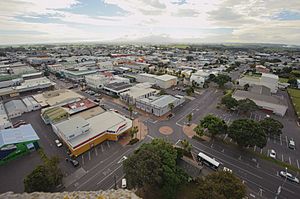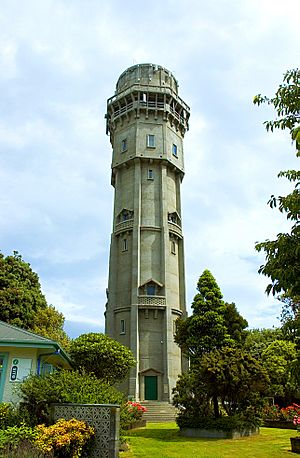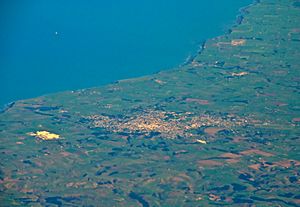Hāwera facts for kids
Quick facts for kids
Hāwera
|
|
|---|---|

Hāwera from the Water Tower
|
|
| Country | New Zealand |
| Region | Taranaki Region |
| Territorial authority | South Taranaki District |
| Ward |
|
| Community | Te Hāwera Community |
| Established | 1866 |
| Electorates |
|
| Area | |
| • Total | 25.18 km2 (9.72 sq mi) |
| Population
(June 2023)
|
|
| • Total | 10,350 |
| • Density | 411.04/km2 (1,064.6/sq mi) |
| Postcode |
4610
|
Hāwera is a cool town in the Taranaki region of New Zealand's North Island. It's the second-biggest town there! About 10,350 people live in Hāwera. It's located close to the coast, near the South Taranaki Bight.
The town started as a military base way back in 1866. A small town then grew around a blockhouse (a strong building) in the early 1870s. Hāwera is about 75 kilometres south of New Plymouth on State Highway 3. It's also just a 30-minute drive from Mount Taranaki. You can also find Hāwera on State Highway 45, which is known as Surf Highway 45 because of all the great surf beaches along it.
Contents
Hāwera's Story
The Name Hāwera
The name Hāwera comes from the Māori language. It means "burnt place." This name came about after a fight between two local groups of people. Their sleeping house (called a whare) was set on fire. Before that, an older Māori name for the area was Tau-patatē. This name referred to a special tree called the patatē, or seven-finger tree. In June 2019, a special mark called a macron was added to the official name, changing it from "Hawera" to "Hāwera."
Fires and the Water Tower
The name "burnt place" sadly became very true for Hāwera. The town had big fires in 1884, 1888, and 1912. Because of these fires, a tall water tower was built right in the middle of town. Its job was to make sure there was enough water pressure to fight future fires. This water tower became a famous landmark in Taranaki! It was closed for a while but was fixed up and reopened in 2004.
Local Marae (Meeting Places)
There are four special marae (Māori meeting places) in the Hāwera area. These are important community hubs for local Māori groups.
- Ngātiki Pa is connected to the Taanga’oe Hapū.
- Te Rangatapu Marae and its Aorangi meeting house are connected to the Ngāruahine hapū.
- Taiporohēnui Marae and its Whareroa meeting house are connected to the Ngāti Ruanui hapū.
- Wharepuni Marae and its Tūpaia meeting house are connected to the Ngāti Ruanui hapū.
In 2020, the New Zealand Government helped out by giving money to fix up some of these marae. This project also created new jobs for people in the area.
Who Lives in Hāwera?
Hāwera covers an area of about 25 square kilometres. In 2018, the estimated population was 10,350.
At the 2018 New Zealand census, Hāwera had 9,792 people living there. This was an increase of 666 people since 2013! There were 3,816 households. About 2,043 people (20.9%) were under 15 years old.
Most people in Hāwera are of European background (78.8%). A good number are also Māori (27.5%). There are also people from the Pacific Islands, Asia, and other parts of the world living in Hāwera.
Hāwera's Main Industries
Dairy Industry
The biggest industry in Hāwera is dairy farming. This means farming cows for their milk. The Whareroa Dairy Factory is a huge place located just outside town. It used to be the largest dairy factory in the world! It's now owned by a company called Fonterra.
During the busiest time of year, about 1,000 people work at the factory. They process up to 14 million litres of milk every day! The factory also has its own power plant. This plant makes electricity and heat for the factory. Any extra electricity it makes is sent out to the national power grid for everyone else to use.
Cultural Attractions
Hāwera is home to the amazing Tawhiti Museum. This museum is famous for its super detailed, life-sized figures and small models. The exhibits show the history and culture of the Taranaki region. You can see detailed models of old Māori pā sites (fortified villages). These displays teach you about how people lived long ago. The Turuturu-Mokai complex is a real archaeological site nearby that connects you to the past.
Schools and Learning
Hāwera has a long history of schools. Hāwera Primary School started way back in 1875!
In 2023, two schools, Hāwera High School and Hāwera Intermediate, joined together. They formed a new school called Te Paepae o Aotea. This new school teaches students from Year 7 to Year 13. It is located on the old Hāwera High School campus. Te Paepae o Aotea currently has about 968 students.
The Western Institute of Technology at Taranaki also has a campus in Hāwera. This is a place where older students can go for further education.
Other primary schools in Hāwera for younger students (Years 1-6) include:
- Hāwera Primary School (roll of 151)
- Ramanui School (roll of 50)
- Tawhiti School (roll of Template:NZ school data)
- Turuturu School (roll of 299)
There are also two state-integrated primary schools (Years 1-8):
- Hāwera Christian School (roll of 33)
- St Joseph's School (roll of 192)
Te Kura Kaupapa Māori o Ngati Ruanui is a special school (Years 1-8) with a roll of 88. It is a Kura Kaupapa Māori school, which means it teaches mostly in the Māori language. All these schools welcome both boys and girls.
Famous Faces from Hāwera
Many interesting people have come from Hāwera! Here are just a few:
- Aroha Awarau, a journalist
- Michael Bent, a rugby player
- Pat Booth, an investigative journalist
- Chester Borrows, a Member of Parliament
- Alan Brough, an actor and comedian
- Gayle Broughton, a rugby union player
- Michael Campbell, a professional golfer
- John Gildroy Grant, a World War I hero who won the Victoria Cross
- Wayne Gould, who helped make sudoku puzzles popular
- Ben Hurley, a comedian
- Peter Ingram, a cricket player
- Fiona Kidman, a writer
- Nicola Kawana, an actress
- Issac Luke, a rugby league player
- John Mitchell, a rugby union player and coach
- Ronald Hugh Morrieson, an author
- Conrad Smith, a famous All Black rugby union player
- Elijah Taylor, a rugby league player
- Adine Wilson, a Silver Ferns netballer
Hāwera's Weather
| Climate data for Hawera (1991–2020 normals, extremes 2004–present) | |||||||||||||
|---|---|---|---|---|---|---|---|---|---|---|---|---|---|
| Month | Jan | Feb | Mar | Apr | May | Jun | Jul | Aug | Sep | Oct | Nov | Dec | Year |
| Record high °C (°F) | 30.7 (87.3) |
28.3 (82.9) |
26.2 (79.2) |
24.2 (75.6) |
21.4 (70.5) |
18.7 (65.7) |
19.0 (66.2) |
19.3 (66.7) |
20.0 (68.0) |
22.9 (73.2) |
23.4 (74.1) |
25.8 (78.4) |
30.7 (87.3) |
| Mean maximum °C (°F) | 25.8 (78.4) |
25.7 (78.3) |
24.8 (76.6) |
21.8 (71.2) |
19.4 (66.9) |
16.9 (62.4) |
16.1 (61.0) |
16.3 (61.3) |
18.3 (64.9) |
19.9 (67.8) |
21.7 (71.1) |
23.7 (74.7) |
26.7 (80.1) |
| Mean daily maximum °C (°F) | 20.7 (69.3) |
21.3 (70.3) |
19.9 (67.8) |
17.6 (63.7) |
15.4 (59.7) |
13.2 (55.8) |
12.3 (54.1) |
13.0 (55.4) |
14.1 (57.4) |
15.5 (59.9) |
16.9 (62.4) |
19.2 (66.6) |
16.6 (61.9) |
| Daily mean °C (°F) | 16.7 (62.1) |
17.1 (62.8) |
15.7 (60.3) |
13.6 (56.5) |
11.6 (52.9) |
9.7 (49.5) |
8.7 (47.7) |
9.3 (48.7) |
10.6 (51.1) |
12.0 (53.6) |
13.2 (55.8) |
15.4 (59.7) |
12.8 (55.1) |
| Mean daily minimum °C (°F) | 12.7 (54.9) |
12.8 (55.0) |
11.4 (52.5) |
9.6 (49.3) |
7.9 (46.2) |
6.2 (43.2) |
5.1 (41.2) |
5.6 (42.1) |
7.1 (44.8) |
8.5 (47.3) |
9.5 (49.1) |
11.7 (53.1) |
9.0 (48.2) |
| Mean minimum °C (°F) | 6.8 (44.2) |
6.6 (43.9) |
4.6 (40.3) |
2.4 (36.3) |
0.8 (33.4) |
−0.4 (31.3) |
−1.2 (29.8) |
−0.6 (30.9) |
0.6 (33.1) |
1.8 (35.2) |
2.9 (37.2) |
5.7 (42.3) |
−1.9 (28.6) |
| Record low °C (°F) | 4.1 (39.4) |
3.7 (38.7) |
0.3 (32.5) |
0.4 (32.7) |
−1.2 (29.8) |
−3.3 (26.1) |
−4.4 (24.1) |
−2.4 (27.7) |
−2.7 (27.1) |
−1.1 (30.0) |
−0.2 (31.6) |
3.5 (38.3) |
−4.4 (24.1) |
| Average rainfall mm (inches) | 70.7 (2.78) |
60.7 (2.39) |
71.1 (2.80) |
104.7 (4.12) |
104.1 (4.10) |
116.6 (4.59) |
117.3 (4.62) |
105.2 (4.14) |
102.4 (4.03) |
105.9 (4.17) |
91.7 (3.61) |
98.9 (3.89) |
1,149.3 (45.24) |
| Source: NIWA | |||||||||||||



